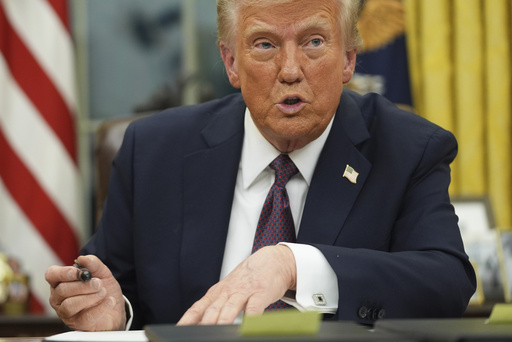WASHNGTON — On Monday, President Donald Trump announced that he anticipates implementing a 25% tariff on imports from Canada and Mexico effective February 1. However, he did not elaborate on his intentions regarding taxes on imports from China during a press conference while signing executive actions upon his return to the White House.
Trump had previously warned of potential tariffs reaching 60% on Chinese goods during his election campaign. Nevertheless, following a recent conversation with Chinese President Xi Jinping, he appeared to soften his stance. “We’re going to have meetings and calls with President Xi,” he stated, indicating plans for further dialogue with China.
In Trump’s view, his executive measures are aimed at reducing energy costs and controlling inflation while strengthening the economy. However, it remains uncertain whether these initiatives will provide the economic growth and lower prices he promised to voters.
Trump attributed the current inflation issues to the $1.9 trillion pandemic relief package enacted in 2021 under the Biden administration. He further criticized his predecessor’s regulations, which he claimed restricted oil production in the U.S., despite the nation being near production records. “The inflation crisis was caused by massive overspending,” he asserted during his inaugural address.
On Monday, he signed orders allowing oil drilling in the Arctic National Wildlife Refuge in Alaska and rolled back regulations concerning oil and gas production. Trump also labeled the situation a national energy emergency, seeking to boost electricity production to compete with China in advancing technologies like artificial intelligence, which demand large amounts of energy.
Additionally, he directed federal agencies to conduct a 30-day review to identify ways to reduce costs associated with housing, healthcare, food, energy, and home appliances. Another signed measure temporarily allows TikTok to seek a U.S. buyer before facing a potential shutdown, granting the platform a 75-day window.
Moreover, Trump signed legislation instructing federal agencies to analyze trade policies and develop an “External Revenue Service” intended for managing customs and duties related to trade. This initiative comes with a series of deadlines set for April.
During his addresses, Trump expressed his eagerness to impose tariffs, emphasizing that foreign nations would foot the bill for these trade penalties, despite the fact that these costs are usually borne by domestic importers and typically passed on to consumers. He confidently claimed that the imposition of these tariffs would lead to significant wealth for the country.
Canadian officials have stated their readiness to handle various potential outcomes related to trade with the United States. Canadian Finance Minister Dominic LeBlanc commented on Trump’s unpredictability in previous terms, saying, “Perhaps he’s made decisions to sort of suspend the threat of tariffs over a whole slate of countries. We will wait and see.”
Trump faces numerous challenges when it comes to realizing his goal of reducing costs. President Biden managed to decrease inflation rates over two years, but he left office with prices still rising faster than wages had been increasing over the past four years.
A continuing driver of inflation remains a significant housing shortage. Moreover, with U.S. oil production at record levels, uncertainty about global demand looms. The Federal Reserve is the federal body responsible for managing inflation, targeting a roughly 2% annual rate. It has used methods such as adjusting short-term interest rates among banks, bond purchasing, and public communications to achieve this.
Trump believes that boosting natural resource production is essential for providing consumers with lower costs, including at the gas pump and in their utility bills. Given that energy prices influence various economic sectors, he argues that enhancing U.S. production of oil, natural gas, and other fossil fuels is crucial for national security. He also criticized the Biden administration for its restrictions on oil and gas production in Alaska.
Though Trump acknowledges the impact of energy prices on the economy, he seems somewhat indifferent to the environmental consequences of fossil fuel reliance, even as he expresses concerns about natural disasters. He reiterated his intention to withdraw from the Paris climate agreement, which hampers global warming efforts and puts a strain on relationships with close allies.
While energy costs can affect overall prices, they comprise a relatively small portion of consumer spending, averaging roughly 6% as per consumer price index assessments. In contrast, expenditures on food and shelter account for 13% and 37%, respectively.
Inflation, which remained subdued for decades, re-emerged in early 2021 as the economy rebounded from COVID-19 lockdowns. A surge in consumer demand overwhelmed U.S. supply chains, causing delays and increasing prices across various products. Manufacturers of goods like computer chips and furniture have struggled to keep up with demand.
Republicans have attributed inflation to Biden’s pandemic relief efforts, although it is a global issue reflecting factors beyond U.S. policy decisions. The situation worsened after Russia’s invasion of Ukraine in February 2022, which significantly increased energy and food prices. The Federal Reserve consequently raised interest rates 11 times over 2022 and 2023 to combat inflation.
Despite a decrease from a record 9.1% in mid-2022, inflation rates increased to an annual rate of 2.9% by December. With voters expressing dissatisfaction over the slow progress in combating inflation, they observed prices still over 20% higher compared to four years earlier, while average earnings lagged behind. The rising cost of groceries, which have gone up 27% since February 2021, has been particularly burdensome.
After the presidential address, Trump downplayed inflation’s significance for the upcoming 2024 election, suggesting that voters are more concerned about immigration issues, as there are only so many ways to discuss rising prices. “How many times can you say that an apple has doubled in cost?” he remarked.




